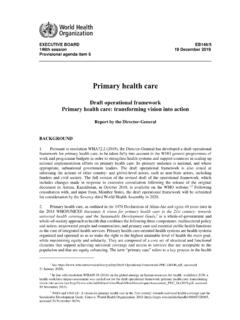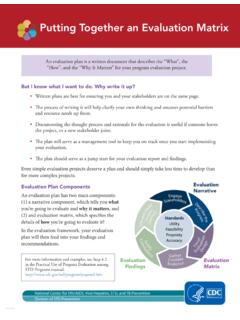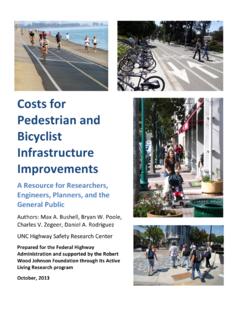Transcription of PUTTING EVIDENCE TO WORK: A SCHOOL’S GUIDE TO …
1 Education Endowment FoundationPUTTING EVIDENCE TO WORK: A SCHOOL S GUIDE TO IMPLEMENTATION Guidance ReportThis guidance report was written by Prof Jonathan Sharples (EEF), Bianca Albers (Centre for EVIDENCE and Implementation), and Stephen Fraser (EEF).The authors were supported by an Advisory Panel which consisted of Prof Annette Boaz (Kingston University), Jane Lewis (Save the Children), and Shaun Allison (Durrington High School). The EEF would like to thank the many other researchers and practitioners who provided support and feedback on drafts of this guidance. CONTENTSE ducation Endowment Foundation PUTTING EVIDENCE to Work: A School s GUIDE to ImplementationForeword Introduction Summary of recommendations Implementation process diagram Recommendations Recommendation 1 Treat implementation as a process, not an event; plan and execute it in stages.
2 Recommendation 2 Create a leadership environment and school climate that is conducive to good implementation. Recommendation 3 Define the problem you want to solve and identify appropriate programmes or practices to implement. Recommendation 4 Create a clear implementation plan, judge the readiness of the school to deliver that plan, then prepare staff and resources. Recommendation 5 Support staff, monitor progress, solve problems, and adapt strategies as the approach is used for the first time. Recommendation 6 Plan for sustaining and scaling an intervention from the outset and continuously acknowledge and nurture its use. How was this guidance compiled?
3 Glossary References 23681012161832363839402 Education Endowment Foundation PUTTING EVIDENCE to Work: A School s GUIDE to Implementation FOREWORDS chools today are in a better position to judge what is most likely to work in their classrooms than they were 10 years ago. We have access to more robust EVIDENCE about which teaching and learning strategies have been shown to be effective - and, as the EVIDENCE base has grown, so too has teachers appetites for generating EVIDENCE can only take us so far. Ultimately, it doesn t matter how great an educational idea or intervention is on paper; what really matters is how it manifests itself in the day-to-day lived reality of schools.
4 That is why we are publishing this latest EEF guidance report, PUTTING EVIDENCE to Work: A School s GUIDE to Implementation. Its aim is to support senior leaders looking to put in place new programmes and practices to think through what you need to do to achieve successful outcomes in your context, whether that s a school, or an early years or post-16 setting. We hope it will help you develop a better understanding of how to make changes to teaching practice by offering practical and EVIDENCE -informed recommendations for effective implementation. To develop the recommendations, we reviewed the best available international research and consulted experts, teachers, and academics. The recommendations cover creating the right conditions for implementation, as well as a structured process for planning, delivering and sustaining change. I hope you find this guidance report useful as a starting point.
5 In particular, we hope it will help you to put make the best possible use of existing EEF resources designed to improve teaching and learning, including: our growing body of guidance reports, providing clear and actionable recommendations on high-priority issues, such as literacy, numeracy and science; and EEF Promising Projects those EEF-funded projects which have demonstrated encouraging findings when first trialled. Everything works somewhere, nothing works everywhere, as Professor Dylan Wiliam famously noted. Implementing effective practices to the best of our abilities is, we think, absolutely critical to yielding the promise that our increased access to EVIDENCE affords. There is a great prize on offer: a consistent, well-led and empowered teaching profession providing better outcomes for all learners, particularly the most disadvantaged. Sir Kevan CollinsChief ExecutiveEducation Endowment FoundationEducation Endowment Foundation PUTTING EVIDENCE to Work: A School s GUIDE to Implementation3 INTRODUCTIONWHY IS IMPLEMENTATION IMPORTANT?
6 Implementation the process of PUTTING a decision or plan into effect. Oxford English Dictionary Vision without implementation is hallucination. Thomas Edison Schools are learning organisations. They continuously strive to do better for the children and young people in their charge. In doing so, they try new things, seek to learn from those experiences, and work to adopt and embed the practices that work best. Implementation is what schools do to improve: to change and be more yet implementation is a domain of school practice that rarely receives sufficient attention. In our collective haste to do better for pupils, new ideas are often introduced with too little consideration for how the changes will be managed and what steps are needed to maximise the chances of success.
7 Too often the who, why, where, when, and how are overlooked, meaning implementation risks becoming an add on task expected to be tackled on top of the day-to-day work. As a result, projects initiated with the best of intentions can fade away as schools struggle to manage these competing of the characteristics that distinguishes effective and less-effective schools, in addition to what they implement, is how they put those new approaches into practice. Often, individuals and schools that implement well tend do so by instinct, or what might be called common sense. Unfortunately, good implementation occupies a rarefied space of uncommon common sense , with too few explicit discussions of the characteristics and qualities that make it effective. The purpose of this guidance is to begin to describe and demystify the professional practice of implementation to document our knowledge of the steps that effective schools take to manage change well.
8 Ultimately, it doesn t matter how great an educational idea or intervention is in principle; what really matters is how it manifests itself in the day-to-day work of people in , it doesn t matter how great an educational idea or intervention is in principle; what really matters is how it manifests itself in the day-to-day work of people in schools. 4 Education Endowment Foundation PUTTING EVIDENCE to Work: A School s GUIDE to Implementation INTRODUCTION CONTINUEDHOW SHOULD I USE THIS GUIDE ?There are legitimate barriers to implementing effectively in schools the bombardment of new ideas and initiatives, limited time and resources, and the pressure to yield quick results, to name just a few. Nevertheless, this guidance report shows a lot can be achieved with careful thought, planning, and delivery using existing resources and structures. It is about making the implicit explicit, providing clarity and purpose to existing processes, and reframing what you are already doing, rather than bolting on a whole new set of procedures.
9 The GUIDE can be used to help implement any school improvement decision, whether programme or practice, whole-school or targeted approach, or internal or externally generated the last few years, the Education Endowment Foundation (EEF) has developed an approach to EVIDENCE -informed school improvement, which treats the school as a continuously improving system. The model aims to frame research EVIDENCE in a school s context, rather than the other way around, integrating the best available external EVIDENCE with professional expertise and internal data. The cycle has five steps:1. Decide what you want to Identify possible solutions and Give the idea the best chance of Did it work?5. Secure and spread suggest schools use this implementation GUIDE as part of an overall advance towards EVIDENCE -informed school improvement. This GUIDE covers all of the steps briefly, but focuses mainly on Step 3, Giving an idea the best chance of success.
10 The EEF has a range of additional resources to support schools across the other steps of this process, for example, the Families of Schools database (Step 1), the Teaching and Learning Toolkit (Step 2), and the DIY Evaluation GUIDE (Step 4).ii See for detailsEducation Endowment Foundation PUTTING EVIDENCE to Work: A School s GUIDE to Implementation5 INTRODUCTION CONTINUEDWHO IS THE GUIDANCE FOR?This guidance is aimed primarily at school leaders and other staff with responsibilities for managing change within a school. Teachers should also find the GUIDE useful in developing a better understanding of how to make practical changes to their classroom practice, as well as their role in supporting departmental or whole-school changes. The guidance may also be useful for: governors and parents looking to support and challenge schools; programme developers seeking to create more effective interventions; policy-makers and system leaders that implement initiatives at a regional scale; and education researchers, in conducting further research on the features and nature of effective IS THIS GUIDE ORGANISED?
















